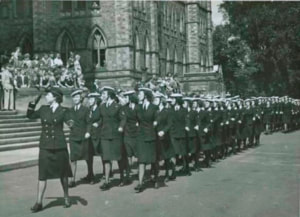 Parade to Parliament Hill on first WECNS anniversary July 1943
Parade to Parliament Hill on first WECNS anniversary July 1943 Sandy Smallwood Preserves Wallis House and Women’s Military History
November 11th in Ottawa is a day of ceremony aimed at remembering the men and women who have served during times of war, conflict and peace. For residents of Lowertown, Wallis House serves as a daily reminder of a military presence in the community that spanned more than fifty years. While its first 75 years were dedicated to health care, after decades with the Department of National Defence, the building itself was in need of serious healing.
Wallis House at the corner of Rideau and Charlotte streets, pictured here in the 1940s, was built in the mid-1870sEnter Sandy Smallwood and his company, Andrex Holdings. In 1994, Public Works put the building up for sale to the highest bidder. Smallwood’s first bid of $1 was rejected and Public Works decided to demolish. However, supported by community groups, Smallwood had a chance to make a second bid of $320,000 – approximately $100,000 more than the $203,000 paid by National Defence Naval Service in 1943.
He recalls that the original multi-year plan to sell the units in phases turned into pandemonium when the first units went up for sale. “By lunch, they had sold out the first phase, which we had expected to take a year,” he says. “By the end of the weekend the whole building was sold out.”
November 11th in Ottawa is a day of ceremony aimed at remembering the men and women who have served during times of war, conflict and peace. For residents of Lowertown, Wallis House serves as a daily reminder of a military presence in the community that spanned more than fifty years. While its first 75 years were dedicated to health care, after decades with the Department of National Defence, the building itself was in need of serious healing.
Wallis House at the corner of Rideau and Charlotte streets, pictured here in the 1940s, was built in the mid-1870sEnter Sandy Smallwood and his company, Andrex Holdings. In 1994, Public Works put the building up for sale to the highest bidder. Smallwood’s first bid of $1 was rejected and Public Works decided to demolish. However, supported by community groups, Smallwood had a chance to make a second bid of $320,000 – approximately $100,000 more than the $203,000 paid by National Defence Naval Service in 1943.
He recalls that the original multi-year plan to sell the units in phases turned into pandemonium when the first units went up for sale. “By lunch, they had sold out the first phase, which we had expected to take a year,” he says. “By the end of the weekend the whole building was sold out.”

 RSS Feed
RSS Feed